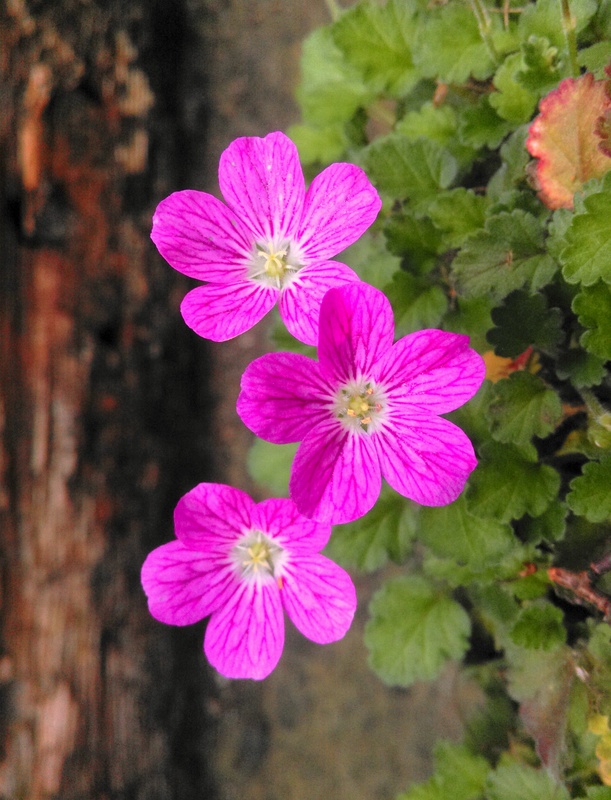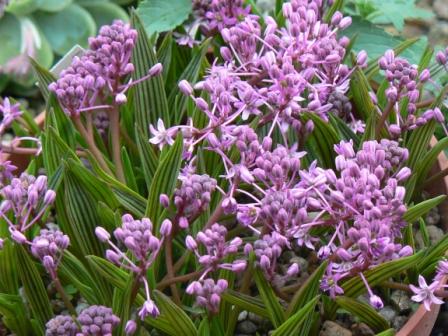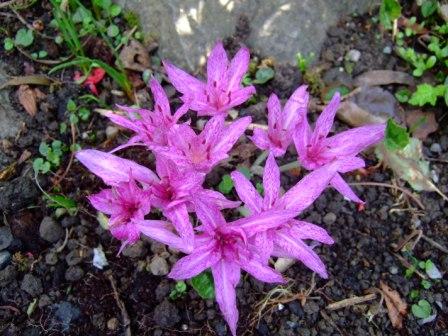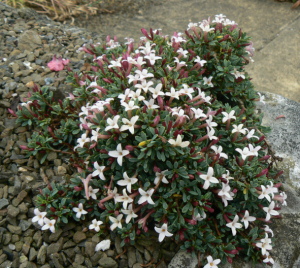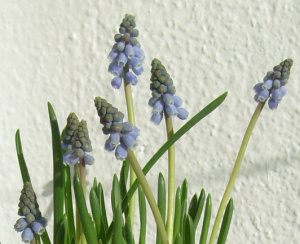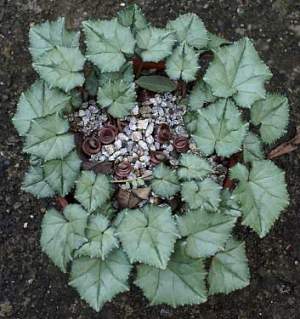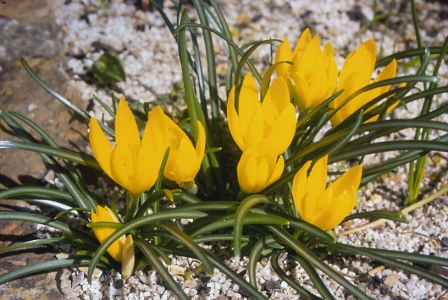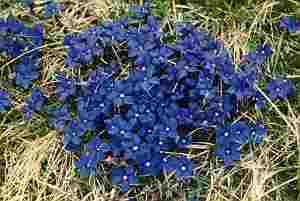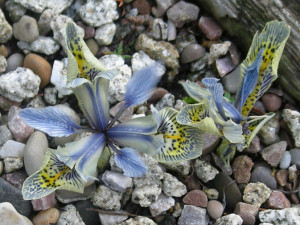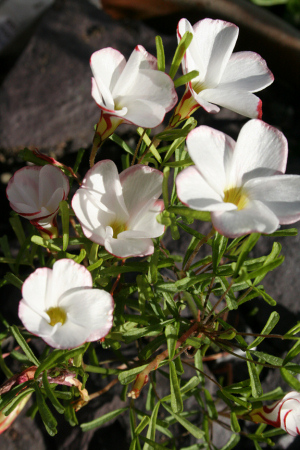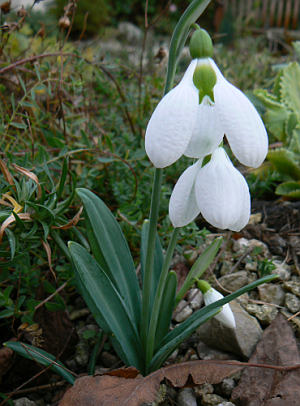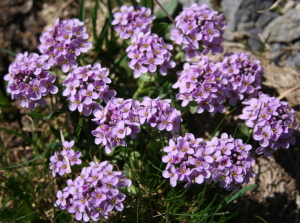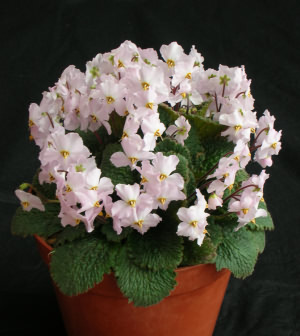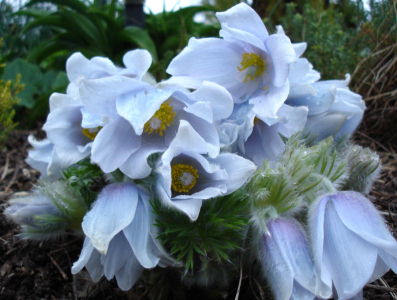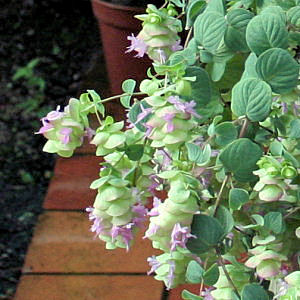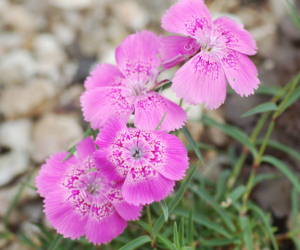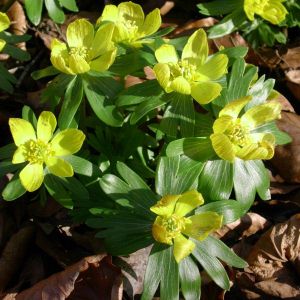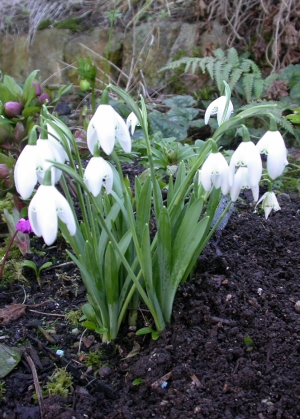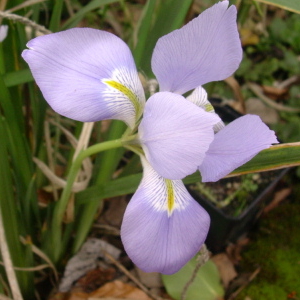Seasonal Focus Plant Archive
Seasonal Focus

March 2019
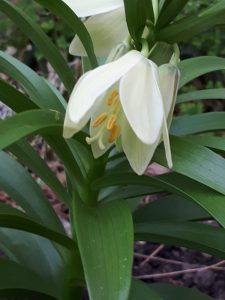 Fritillaria raddeana , which started to flower in my garden in late February, earlier than the books say, as with much else this season. Related to imperialis, it doesn't have the off-putting foxy smell. From Central Asia - Iran, Turkmenistan, Afghanistan.
Fritillaria raddeana , which started to flower in my garden in late February, earlier than the books say, as with much else this season. Related to imperialis, it doesn't have the off-putting foxy smell. From Central Asia - Iran, Turkmenistan, Afghanistan.
Jamie Chambers.
June 2018
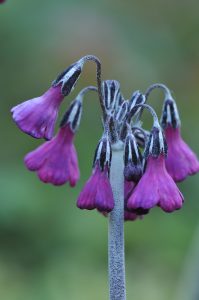 Primula secundiflora in what I've begun to think of as my primula patch. Hailing from China (north-west Yunnan and south-west Sichuan) it loves plenty of moisture in the spring, and doesn't mind being shaded and rather drier in the summer. Reputedly it self-seeds readily, but I've yet to see that. If it does, you'll see it in our plant sales.
Primula secundiflora in what I've begun to think of as my primula patch. Hailing from China (north-west Yunnan and south-west Sichuan) it loves plenty of moisture in the spring, and doesn't mind being shaded and rather drier in the summer. Reputedly it self-seeds readily, but I've yet to see that. If it does, you'll see it in our plant sales.
Jamie Chambers.
|
October 2015
|
Erodiium reichardii 'Bishop's Form' grows very well for me in a trough, giving colour throughout the summer and well into autumn. It's well behaved too, spreading only slowly. Jamie Chambers. |
|
September 2011
|
Ledbouria cooperi. This is a small bulb from South Africa that is easily grown in full sun and well drained soil. I got it from John McWhirter as Scilla adlamii but, as usual, it has been moved into another genus, changing the name. The flowers are small but numerous and the leaves are attractive in themselves with purple stripes. It seems to spread by stolons. I grow it in a trough and in pots as my soil is heavy clay. Val Keegan. |
|
January 2011
|
Iris reticulata in our garden last year. It is easy to grow and will flower as early as Feburary or March. The flowers are a deep violet-blue with a golden spot in the centre of the lower, drooping petal. This little Iris, only about 6 inches high, is suitable for edging, rock gardens and paving pockets where the plants can be left undisturbed. Its beauty makes a welcome sight at the beginning of the year indeed. AnneMarie Keoghan |
|
March 2010
|
The garden may be behind with our current cold snap and the snowdrops have been superb but it is nice to see other plants joining them. Corydalis malkensis does well with me in our heavy soil so I am sure it will succeed anywhere. I am now watching for some of the other excellent Corydalis to appear. Val Keegan. |
|
December 2009
|
Cyclamen persicum, grown from seed from one of the collections made by the Cyclamen Society. Florists' cyclamen are the products of generations of selection from wild Cyclamen persicum. They generally have lost the scent and, in my opinion, the charm of their wild ancestors. They can be grown in a pot indoors and generally flower between Autumn and Spring. George Sevastopulo. |
|
October 2009
|
Colchicum agrippinum. This old hybrid, probably between Colchicum variegatum and Colchicum autumnale, is one of the easiest colchicums to grow. It is moderately tall and does flop, but produces so many flowers from one corm, it can be forgiven. AnneMarie Keoghan. |
|
September 2009
|
Sedum cauticolum is one of the easiest sedums to grow and one of my favourites. It is compact and does not straggle like some others, and it flowers at the end of the season. Its grey leaves are a good contrast to other plants. Val Keegan. |
|
August 2009
|
Daphne jasminea. This specimen, in a trough in Wisley, is still in full flower in August. A native of Greece, it is tender and outdoor growing is not easy. Winter protection is needed in very cold areas and wet protection in others. It is still the most beautiful of a lovely family. Val Keegan.
See Brickell, C D & Mathew, B: Smaller Daphnes or White, Robin: Daphnes: a practical guide for gardeners in our library for more information. Philip ShuttleworthA longstanding member, and in recent years an honorary member, Philip Shuttleworth died after a long illness, aged eighty seven. He was buried on July 21st in Julianstown, Co. Meath. Val & Ian Keegan and Anne & Billy Moore attended the funeral on behalf of the Group. Philip was one of the greatest alpine growers this country has known. His garden in Gormanstown with its extensive tufa beds and huge collection of choice alpines (alas due to increasing frailty falling into decline in latter times) was a Mecca for lovers of alpines from all over. Philip was of enormous assistance to the Group in the early years and was almost embarrassingly generous. All the old stagers will be able to point to plants in their gardens that they got from him. Rhona, Philip’s wife, who died seven years ago was also a great gardener, though her interests were more in the direction of mainstream garden plants, especially primulas. Between them they brought a wide variety of plants to the Country Markets. They were a wonderful and very likeable couple. As a large farmer Philip seemed an unlikely grower of alpines and it is remarkable that with his professional workload he was able to garden to such a high standard and to find time for his many other interests: he is an example to all of us. He is survived by his son, Fred, his daughters Ann and Rhona and grand- and great-grandchildren to all of whom we must offer our condolences on their loss. |
|
July 2009
|
Zaluzianskaya ovata. This compact South African plant is named after Adam Zaluziansky von Zaluzian, a 16th-century Bohemian botanist. It has aromatic, evergreen foliage that forms a dense neat dome. Deep maroon buds, that have the appearance of match-heads, open during the very early part of the day to reveal pure white upper parts to the flower, which is made up of heart-shaped petals. During the heat of the day they will close up again. At night, a rich and heady perfume can be detected but only if I get quite close. This plant is not reliably hardy, according to the literature, and will grow best in pots in a sheltered position but has survived one winter in the open garden and hopefully will last a few more seasons to come. AnneMarie Keoghan.
See Pooley, Elsa: Mountain flowers: a field guide to the flora of the Drakensberg and Lesotho in our library for more information. |
|
June 2009
|
Tulipa iliensis is from Soviet Central Asia. These particular bulbs were purchased at the Members’ Show and Plant Sale in Autumn 2008. They are growing outside in a well-drained gritty soil, and the flowers opened on April 1st. Joan Carvill.
The Midsummer 25th Anniversary Party was very enjoyable, even the weather being in reasonable spirits and enabling Bob Gordon of the Northern Group to plant a Betula utilis var jacquemontii 'Trinity College' to commemorate the occasion. The speeches from Dr. Peter Wyse-Jackson, Val Keegan and Carl Dacus, and the award of honorary membership to Helen Dillon lead up to the climax of the evening, the consumption of Rose Sevatopulo's latest creation, a tufa rock garden, washed down with champagne. Take a look at the photos here. Joan Carvill and Anna NolanWe had two sad months, with the deaths of two notable members. In May our long-standing founder member and Secretary, Joan Carvill, died suddenly while on a wine-tasting tour of Italy with her daughter Julie. Joan's contribution to the Society, from its very beginning, was enormous, and the success of the annual Alpine Weekend at Termonfeckin stands as a testament to her talents of imagination and organisation. It is particularly poignant that she died such a short time before the Anniversary Party, which she was so looking forward to. Then in June, Anna Nolan passed away after a long illness. Anna, a fine gardener, was a very prominent member of the Society from the outset and for many years looked after our plant sales and library. The picture shows Joan Carvill and Michael Higgins at the National Botanic Gardens. |
|
March 2009
|
Hacquetia epipactis. A lovely Spring woodlander with luminescent yellow-green flowers. This pretty little plant, with glossy leaves topped in early spring (Feb - March) with tiny acid yellow flowers surrounded by lime-green bracts, spreads slowly, and doesn't like root disturbance, so place it carefully, away from more vigorous plants which may swamp it. Moist humus-rich neutral to acid soil in shade. Anne-Marie Keoghan. |
|
February 2009
|
Muscari armenaicum is much better behaved than the rather invasive neglectum which I'm working hard to eliminate from my garden. The flowers, sky-blue with white 'teeth', appear with the modest set of leaves very early in the season. Last winter they were well out before Christmas, but this year's cold delayed them until the end of January. Jamie Chambers. |
|
January 2009
|
Cyclamen hederifolium is the easiest cyclamen of all to grow. It is totally hardy, produces its flowers in various shades of pink as well as pure white freely in August/September. Once established it will seed around and will build up to a substantial clump in no time. No garden should be without this plant but not necessarily because of its flowers although they are beautiful. Its foliage is almost infinitely variable both in colour, shape and patterning and remains in good condition from flowering time to May/June in the following year giving a handsome display right through the winter. It is easily grown from seed but if you can’t wait and know someone who grows it they will almost certainly have some tubers to spare. It can be transplanted at any time of the year and is not fussy about soil type. It will do best in semi-shade. It may not be rare or exotic but it is a very fine plant. Billy Moore. |
|
October 2008
|
Sternbergia sicula from Crete needs the sunniest position that you can afford it. It flowers in late September and is a good guide to the amount of sun that there had been in the previous summer. Guess how many flowers it had this year – three! George Sevastopulo. |
|
September 2008
|
Verbascum x letitia. Perhaps the finest mullein for the rock garden (according to Christopher Grey-Wilson) it enjoys a well-drained soil in a sunny postion. Leaves are grey-green and the flower spikes a welcome clear primrose yellow among the many purples at this time of the year. It should eventually form a low, compact, twiggy shrub 20 cm high and 30 cm wide. AnneMarie Keoghan. |
|
May 2008
|
Gentiana verna, taken by Peggy Parker. |
|
April 2008
|
Raymond Copeland's Farrer medal winning Saxifraga porophylla at our Annual Show. Photo: Billy Moore. |
|
March 2008
|
Iris 'Katherine Hodgkins', a hybrid of Iris winogradowii and Iris histrioides. I have had it a few years and it normally flowers in early spring. To my surprise I found it in full bloom on a raised bed in my garden on the 28th of Dec. last. Patricia Maguire. |
|
February 2008
|
Oxalis versicolor. A slip given to me by Valerie Keegan, planted up in a pot and forgotten about, delighted us this January with a show of lovely flowers. Closed up, the flowers have this effect of red and white candy stripes but open up into pure white flowers, just slightly fringed by red, with a soft yellow centre. Oxalis versicolor is from the South West Cape (with predominantly winter rainfall), starting to grow in autumn and flowering in winter/spring before becoming dormant for a dry summer rest period. Best grown in a frost-free glass-house with plenty of light and air through the winter months. Does anybody grow it in the open? AnneMarie Keoghan. |
|
January 2008
|
Galanthus plicatus ‘Three Ships’ is one of the very early flowering snowdrops. It is described in ‘The Alpine Gardener’ December ’05. The original bulb was found in an old garden in Suffolk by John Morley 20 years ago. I can see it from my kitchen window, where it has been in flower since early November and still looks very well in an otherwise dormant alpine bed. Val Keegan. |
|
October 2007
|
Aquilegia scopulorum var. perplexans comes from Nevada. It is about 7.5 cm tall and is growing in a gritty compost in a 9 cm pot. I grew it from seed which I got from Vojtech Holubec in 2005. It should normally flower in spring so it’s a bonus to get flowers at this time of year. According to the AGS encyclopaedia “all variants of A. scopulorum are amongst the most desirable aquilegias for scree and alpine house and are easier to grow than A. jonesii”. Billy Moore. |
|
September 2007
|
Thlaspi rotundifolium. A wonderful sight in the wild. Found in limestone scree, it sends down deep into the shingles a well anchored taproot, above which are fairly undistinguished clumps of small leaves. The flowers (in June/July) consist of flattened heads of soft, daphne-pink flowers with a scent of honey. AnneMarie Keoghan. |
|
July 2007 |
Liam Byrne's Farrer Medal winning Ramonda myconii at our Annual Show. Photo: Jamie Chambers. |
|
April 2007
|
Pulsatilla 'Budapest'. I had the fortune to win this beautiful form of Pulsatilla vulgaris in a raffle of the Foxrock & District Garden Club five or six years ago. Harold McBride was the speaker that night and brought this plant together with other treasures. I would not have chosen it but for the advice of another member. It was a very small little seedling with no flowers to appeal to the complete beginner that I was. After Mr. McBride's wonderful lecture he congratulated me on my choice and described the plant and its history. He later sent me a photo together with a form to join the AGS. The plant sits very happy in the garden. It gets little attention apart from mulching twice a year and the number of flowers has increased steadily over the years. Conchita Nolan. |
|
February 2007
|
Helleborus torquatus, here in Anna Nolan's garden, is a species hellebore that has very attractive divided foliage and colours that range from very dark to this understated beautiful green and brown. Carmel Duignan. |
|
December 2006
|
Narcissus 'Cedric Morris' is a miniature daffodil that is not only beautiful but is early flowering. It always manages to have a flower by Christmas. Bulbs are difficult to come by because (in my experience) they bulk up very slowly and do not set seed. Carmel Duignan. |
|
September 2006
|
Origanum 'Barbara Tingey' grows here in Dublin on a sunny raised bed. I also grow it in pots in the Alpine House which are put outside on the terrace in summer. I've grown it for twenty five years or so, and sometimes propagate it from short basal cuttings from the centre of the plant in spring, about 2 inches (6cm) tall, which are rooted in a sand bed. It also enjoys comfortable living when in flower in the greenhouse where it is decorative for many months. Easily displayed standing on another pot. I suspect that Origanum rotundifolium may be involved in its parentage. Helen Dillon. |
|
August 2006
|
Physoplexis comosa (syn. Phyteuma comosum). The so-called Devil's claw is one of the classic alpines. A native of the southern Alps, particularly the Dolomites, it grows in deep crevices in limestone and dolomitic formations. Flowers appear in summer, somewhat bottle-shaped to 2 cm long, pinkish-blue blooms, tipped with black. It is safest in the Alpine house though it will grow on raised beds, scree or troughs where it must be protected from slugs and snails, and winter wet. AnneMarie Keoghan. |
|
June 2006
|
Dianthus callizonus is a native of South Eastern Europe. It forms a neat cushion of glaucous leaves with large, fringed flowers that are pink with a white and crimson centre. Likes a sunny spot. Carmel Duignan. |
|
May 2006
|
To my mind, Paeonia cambessedesii is the star of the paeony genus, mainly because of its beautiful foliage. The flowers are gorgeous and as well as the lustrous rich pink silky petals they have a distinctive perfume reminiscent of cloves. Unfortunately, as with all paeonies, the flowers are fleeting, lasting no more than ten days. But even out of flower it is a wonderful plant and indeed, while I love the flowers, I grow it mainly for its foliage which is beetroot red when it first emerges in early spring, maturing to a green metallic hue with red veins on the upper surfaces and reddish underneath with deep pink stems. The seed pods are also highly decorative. Although it comes from the Balearic Isles it is quite hardy but does best in a sunny sheltered site. I have grown it outside for many years without difficulty - it is easy from seed. A superb specimen of P. cambessedesii was awarded the Farrer Medal at the Ulster Show this year. Billy Moore. |
|
March 2006
|
Eranthis hyemalis is best known as a ‘winter aconite’, and is a cheerful early introduction to spring. It is tiny, 5 – 15cm high, and has a ruff of well dissected leaves. Aconites are members of the Ranunculaceae family and grow from small tuberous rhizomes. They are native to southern Europe. This is Eranthis ‘Guinea Gold’, a sterile hybrid which has larger flowers. Val Keegan. |
|
February 2006
|
Seen in late January 2006, this is of one of the more reliable (and cheaper) double snowdrops, Galanthus 'Lady Beatrix Stanley'. Before she was formally named, 'Lady S' was distributed as G. caucasicus double form. The inner segments generally form a nice tight rosette but the attractive regularity is spoiled in a few flowers each year by one or more long inner segments. Whether this aberration is fixed, recurring from year to year in the same bulbs, I do not know. The outer segments are relatively narrow, allowing a clear view of two small green dots, one on each side of the sinus, which is typical of this cultivar. Flowering times according to my records, which extend back several years, are quite variable. The earliest well developed flowers were in the first week in January in 2005, but mid January is more usual and the flowers stay in good condition into the first week in February. George Sevastopulo. |
|
January 2006
|
Iris unguicularis is the most commonly grown winter-flowering iris, forming clumps in sunny, well-drained conditions. Originally from North Africa and the eastern Mediterranean, the flowers are fragant, opening from late autumn to early spring. Val Keegan. |

